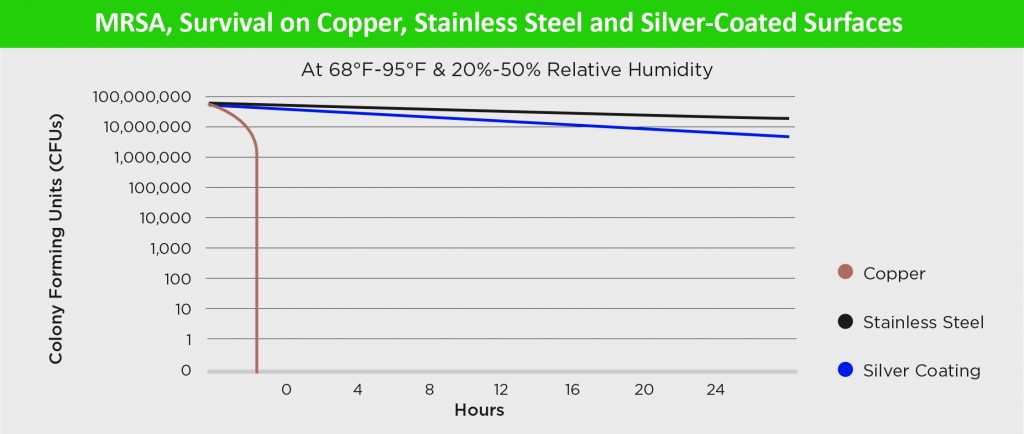Above all, the door handle of a public facility can be touched several thousand times per day. That is thousands of opportunities to transfer bacteria and infectious diseases. In hospitals alone, there are over 103,000 Hospital Acquired Infections (HAIs) reported every year! We specialize in Antimicrobial Door Hardware in Healthcare settings.
Significant progress has been made in preventing some healthcare infection types, there is much more work to do. On any given day, about one in 31 hospital patients has at least one healthcare-associated infection.
CDC publishes data reports to help track progress and target areas that need assistance. The data come from two complementary HAI surveillance systems, the National Healthcare Safety Network (NHSN) and the Emerging Infections Program Healthcare-Associated Infections – Community Interface (EIP HAIC).
We have all heard that human coronavirus 229E produces a wide range of respiratory symptoms from the common cold to more lethal outcomes such as pneumonia. It can survive on surface materials including ceramic tiles, glass, rubber and stainless steel for at least five days.
While human-to-human transmission is common, infections can also be contracted by touching surfaces contaminated by respiratory droplets from infected individuals or hand touching, leading to a wider and more rapid spread.
Antimicrobial Copper Door Hardware
On copper, and a range of copper alloys – collectively termed ‘antimicrobial copper’, likewise the coronavirus was rapidly inactivated (within a few minutes, for simulated fingertip contamination). Exposure to copper destroyed the virus completely and irreversibly, leading the researchers to conclude that antimicrobial copper surfaces, could be employed in communal areas and at any mass gatherings to help reduce the spread of respiratory viruses and protect public health.
Oregon Door Consultants can help minimize infectious bacteria* certainly, in your facility through our antimicrobial portfolio of products made with CuVerro® bactericidal copper alloy surfaces.
Hardware products that are manufactured with CuVerro® bactericidal copper alloys are registered with the U.S. Environmental Protection Agency (EPA). Surfaces cleaned regularly have proven to kill 99.9% of the most virulent bacteria* like e-Coli, MRSA and Staph. CuVerro® is not a coating, but a solid copper-base alloy with inherent bactericidal properties that will last for the life of the product

CuVerro is the only class of solid surface materials on the registry with the U.S. Environmental Protection Agency (EPA) to actively kill bacteria. The antibacterial properties work 24/7 in between cleaning, never washing out or wearing away, making CuVerro ideally suited for commonly touched surfaces where bacteria is a concern. Easy to maintain, CuVerro is tarnish-resistant and will not oxidize and turn green like pure copper.
Benefits of using Oregon Door Consultants portfolio of Antimicrobial Copper Door Hardware products:
- Kills 99.9% of bacteria* in 2 hours.
- Not a coating and won’t wear off! Will continue to kill bacteria* even more, for the lifetime of the product.
- Looks like stainless steel to match other hardware products.
- Wide range of hardware and touch surfaces available.
- Made in the U.S.A.
- “Green” product comprised of pre and post consumer recycled materials.
Hospital Acquired Infections (HAI) number over 103,000 cases per year nationally. Combined with home and school acquired infections, the total rises to over 2 million every year causing lost workdays and absenteeism. Treatment cost estimates range between $35 and $45 billion dollars annually and are rising. Also, the EPA tests conducted using Good Laboratory Practices demonstrated the effectiveness of copper alloys against bacteria* that cause infection. Oregon Door Consultants partner with leading manufactures who are pioneers and innovators in copper door hardware.
Q: How does Antimicrobial Copper kill bacteria?
A: Copper is an essential nutrient for humans as well as bacteria, but in high doses, copper ions can cause a series of negative events in bacterial cells. Research for the precise chemical and molecular mechanisms responsible for copper’s antimicrobial capabilities is ongoing. Several theories exist that include concepts that elevated copper levels:

1. Rupture the cell membrane wall, leading to leakage of specific essential cell nutrients, such as potassium and glutamate, and subsequent cell death.
2. Disrupt osmotic pressure (osmotic balance), weakening the cell wall and allowing contents to leak out.
3. Bind to proteins that do not require copper for their function. So while copper is necessary for many protein functions, in excess situations, this “inappropriate” binding leads to loss-of-function of the protein, and/or breakdown of the protein into nonfunctional portions.
4. Cause oxidative stress and the generation of hydrogen peroxide. Under these conditions, copper participates in the so-called Fenton-type reaction a chemical reaction causing oxidative damage to the cell.
5. “Steal” electrons from the lipids in the cell membrane, certainly, causing oxidative degradation, which leads to cell death. (Lipid peroxidation)
Copper hardware helps combat deadly pathogen transmission
While the exact mechanism by which copper kills bacteria is still unknown, the laboratory data on copper’s effectiveness is compelling. CuVerro® alloys can be incorporated into a range of health care equipment and furnishings, providing an active surface that kills greater than 99.9% of bacteria within 2 hours.
The effectiveness of the copper alloy is important because “hospital-acquired infections sicken approximately 2 million Americans annually, and kill nearly 100,000,” Dr. Michael G. Schmidt, University of South Carolina, Charleston, added. It is the eighth leading cause of U.S. deaths. In November, the American Society of Microbiology released a new study, which discovered that copper hospital beds in intensive care units had 95 percent fewer bacteria than conventional beds. Copper alloy surfaces in commercial buildings, homes, and schools – albeit more expensive to install – are disease fighters that can significantly lower infection and death rates.
Our next page deals with an alternative to Antimicrobial Copper which is Antimicrobial Coatings

Contact us today!
We can find the right option for your hospital. Finally, as door professionals we are up to date on all door hardware finishes and materials to include those that kill bacteria.
Please call us at 800-621-0790 or leave us your contact information with a detailed message. One of our team will get back to you directly.




